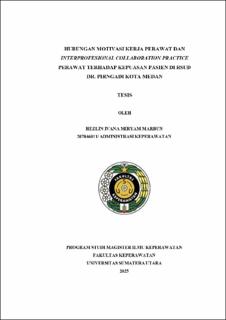| dc.contributor.advisor | Nasution, Siti Saidah | |
| dc.contributor.advisor | Nurhidayah, Rika Endah | |
| dc.contributor.author | Marbun, Hezlin Ivana Miryam | |
| dc.date.accessioned | 2025-07-18T09:11:22Z | |
| dc.date.available | 2025-07-18T09:11:22Z | |
| dc.date.issued | 2025 | |
| dc.identifier.uri | https://repositori.usu.ac.id/handle/123456789/105782 | |
| dc.description.abstract | Nurse work motivation arises from internal individual drives as well as the influence of the surrounding environment that encourages actions related to their job. Interprofessional collaboration in nursing practice refers to cooperation between nurses, other medical team members, and patients. Patient satisfaction is a reflection of their perception of the quality of care provided, compared to their expectations. The aim of this study is to explore the relationship between nurse work motivation and patient satisfaction levels, as well as the influence of interprofessional collaboration in nursing practice on patient satisfaction at Dr. Pirngadi General Hospital in Medan City in 2024. This study uses a quantitative approach with a correlational design. The study sample consists of 99 respondents, including nurses and inpatients, selected through convenience sampling. Data collection was carried out using a questionnaire, and data analysis was performed using the Spearman Rank statistical test. The results show that the majority of nurses have high work motivation, with 76 people (76.8%), the majority also demonstrate good interprofessional collaboration practices, with 58 people (58.6%), and the majority of patients are satisfied with the care they received, with 58 people (58.6%). The study found a significant relationship between nurse work motivation and patient satisfaction, with a ρ value of 0.027 (p<0.05). The correlation coefficient of 0.222 indicates that the higher the nurse's work motivation, the higher the level of patient satisfaction. Additionally, the study also indicates a significant relationship between nurse interprofessional collaboration practices and patient satisfaction, with a ρ value of 0.007 (p<0.05). The correlation coefficient of 0.270 indicates that an increase in nurse interprofessional collaboration is aligned with an increase in patient satisfaction. | en_US |
| dc.language.iso | id | en_US |
| dc.publisher | Universitas Sumatera Utara | en_US |
| dc.subject | Nurse Work Motivation | en_US |
| dc.subject | Interprofessional Collaboration Prcatice Nurse | en_US |
| dc.subject | Patient Satisfaction | en_US |
| dc.title | Hubungan Motivasi Kerja Perawat dan Interprofesional Collaboration Practice Perawat terhadap Kepuasan Pasien di RSUD Dr.Pirngadi Kota Medan | en_US |
| dc.title.alternative | Correlation between Nurses' Work Motivation and Nurses' Interprofessional Collaboration Practice on Patient Satisfaction at Dr. Pirngadi Hospital Medan in 2024 | en_US |
| dc.type | Thesis | en_US |
| dc.identifier.nim | NIM207046011 | |
| dc.identifier.nidn | NIDN0027037502 | |
| dc.identifier.nidn | NIDN0020017602 | |
| dc.identifier.kodeprodi | KODEPRODI14101#Ilmu Keperawatan | |
| dc.description.pages | 180 Pages | en_US |
| dc.description.type | Tesis Magister | en_US |
| dc.subject.sdgs | SDGs 4. Quality Education | en_US |


